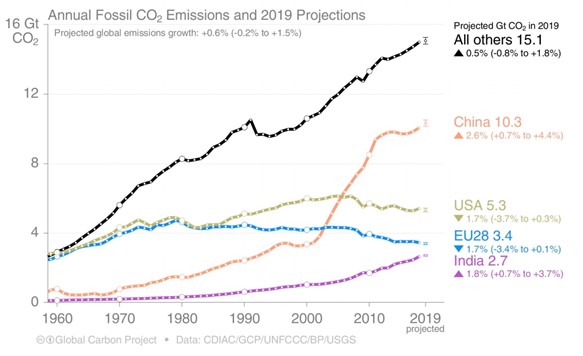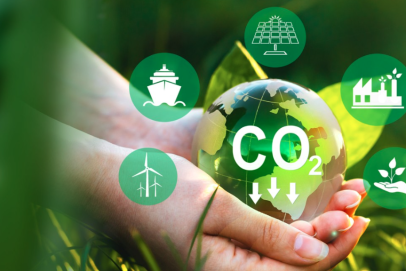It’s time to check your Business’s Carbon budget!
Climate change will bring unpredictable effects to human life in the future. Carbon budget tracking and management play a significant part in global efforts to reduce greenhouse gases and prevent climate change.
1. Effects of climate change
Many of us are standing on the sidelines in efforts to tackle climate change and assume the responsibility lies in the next generations or developed countries. However, if prompt actions are not taken today, the effects we suffer in the future will be serious and unpredictable:
- Rising sea levels: Global warming melts ice and raises sea levels, causing floods, high tides, land shrinkage, and landslides in coastal areas.
- Severe weather: Global warming can lead to more extreme weather events, such as storms, floods, droughts and heat waves, causing loss of life and property, and disruption of economic activities.
- Environmental disasters:Global warming can lead to environmental disasters, such as biodiversity loss, forest fires and the demise of coral reefs.
- Human health: Global warming can affect human health in many ways, such as increasing the risk of heart disease, stroke, cancer and respiratory diseases. Rising temperatures can also worsen mental health problems.
Description 1: Chart of carbon footprints (CO2) over the past 60 years
2. The fight against climate change – the Paris Agreement 2015
In 2015, the Paris Agreement was signed with the consent of more than 140 countries in the context of 700 coastal cities around the world being at the risk of flooding or even disappearing (according to the Climate Central 2021 report).
The Paris Agreement is a legally binding international treaty on climate change. It was adopted at the UN Climate Change Conference (COP21) in Paris, France, on 12 December 2015. Its overarching goal is to limit greenhouse gas emissions, hold the increase in the global average temperature to well below 2°C above pre-industrial levels and pursue efforts to limit the temperature increase to 1.5°C above pre-industrial levels.
“Pre-industrial levels” refers to the concentration of greenhouse gases in the atmosphere before the Industrial Revolution. This level is often used as a benchmark to measure the progress of climate change. The latest research shows that the concentration of CO2 in the atmosphere in May 2022 has reached 420 ppm, 50% higher than pre-industrial levels. The US National Oceanic and Atmospheric Administration (NOAA) emphasized on June 3, 2022 that this is the record highs in about 4 million years. The current 420 ppm level is roughly equivalent to an estimated level of above 400 ppm 4.1 to 4.5 million years ago. Sea levels then were 5 to 25 m higher than they are now, which were capable of submerging many major cities today. This increase in CO2 levels are caused by the burning of fossil fuels, such as coal, oil and natural gas.
Before the “industrial revolution”, CO2 concentrations remained stable at 280 parts per million (ppm) for about 6,000 years of human civilization. Scientists believe that this is a safe level for the planet. If greenhouse gas emissions continue to rise at the current rate, atmospheric CO2 levels could reach 500 ppm by the end of this century. This could create catastrophic impacts on the planet, including rising sea levels, more extreme weather events and disruption to agricultural production.
The Paris Agreement includes several key provisions:
- Nationally Determined Contributions (NDCs): NDCs are non-legally binding commitments voluntarily made by countries that include their specific actions and targets to reduce national emissions and adapt to the impacts of climate change.Each participating country in the Paris Agreement is required to submit its own NDC, which outlines targets for mitigating its carbon footprint NDCs are periodically updated.
- Financial support: Developed countries are committed to providing financial support to developing countries to help them reduce emissions and cope with the impacts of climate change.
- Adaptation: Participating countries commit to adapting to the effects of climate change. This includes investment in measures such as building breakwaters to protect coastal communities from rising sea levels.
Description 2: Remaining carbon budget
3. Carbon budget
The carbon budget indicates the cumulative amount of greenhouse gas, mostly carbon dioxide (CO2), that we can still emit to keep global warming below specific limits. The Paris Agreement’s goal is to keep average temperature increases to “well below” 2 degrees Celsius and, preferably to 1.5 degrees Celsius compared to pre-industrial levels. Carbon budget tracking and management play a significant part in global efforts to reduce greenhouse gases and prevent climate change.
Description 3: Carbon budget allocation
The world carbon budget will be allocated to countries and then from countries to businesses. Carbon budgets are often divided among different countries and regions based on factors such as population, emissions history, and payment ability.
4. What does a carbon budget have to do with my business?
A carbon budget works the same way as a financial budget of a business or country. The amount of greenhouse gases we emitted, the remaining amount we can use, and how to achieve the emission goals set by the Vietnamese government are questions that are currently troubling business owners in Vietnam.
When facing the risks posed by new regulations on climate change, apart from accepting fines or taxes, businesses can:
- Carbon Accounting/GHG Accounting: Carbon accounting allows organizations to quantify their greenhouse gas emissions, understand the impact of their business activities and set goals to reduce their emissions. Read more about “carbon accounting” here..
- Switch to renewable energy sources: Renewable energy is becoming cheaper and more efficient. Businesses can transition to renewable energy by installing solar panels on their rooftops, purchasing electricity from renewable energy suppliers, or investing in renewable energy projects.
- Enhance energy efficiency: Businesses can limit emissions by changing the way how they harness energy in buildings, factories and vehicles. This can be done by installing better insulation, the use of energy-efficient equipment and the optimization of manufacturing processes.
- Invest in new technologies:New technologies, such as carbon capture and storage, can help mitigate businesses’ emissions. This is a technology that allows carbon to be separated from emissions and stored underground, usually including three main stages: capture, transport, and storage.
- Buy emission reduction credits (carbon credits):Carbon credits are certificates that represent the equivalent of one ton of carbon dioxide (CO2) or other greenhouse gas emissions that is either reduced or removed from the atmosphere. Carbon credits are used in greenhouse gas emission reduction programs, such as the Clean Development Mechanism (CDM) of the United Nations Framework Convention on Climate Change (UNFCCC). Carbon credits can be bought and sold on the open market. Businesses and organizations can purchase carbon credits to offset their emissions. This can help them meet greenhouse gas emissions targets or comply with environmental regulations.
Green transformation is a complex process that requires in-depth knowledge and experience from leading experts. Our team of specialists is always ready to support businesses in the green transformation process from consulting to reporting.
Exclusive article by FPT IS Technology Expert
Pham Tuan
VertZero Product Manager
FPT Information System Company.















